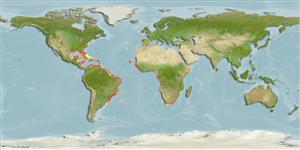Teleostei (teleosts) >
Holocentriformes (Squirrelfishes, soldierfishes) >
Holocentridae (Squirrelfishes, soldierfishes) > Myripristinae
Etymology: Corniger: Latin, cornus + horn + Latin, gero = to carry (Ref. 45335).
More on author: Agassiz.
Environment: milieu / climate zone / depth range / distribution range
Ecology
Marine; demersal; depth range 45 - 275 m (Ref. 7251). Tropical
Western Atlantic: South Carolina, USA to Cuba and Brazil. Eastern Atlantic: St. Helena (Ref. 5288). Eastern Atlantic: Cape Verde Islands (Ref. 94080).
Size / Weight / Age
Maturity: Lm ? range ? - ? cm
Max length : 20.0 cm TL male/unsexed; (Ref. 7251)
Dorsal
spines
(total): 12;
Dorsal
soft rays
(total): 14;
Anal
spines: 4;
Anal
soft rays: 11. Body bright red, unstriped, darker above, with a dark, brownish red are below soft dorsal fin. Preopercle with large spine at angle and smaller stout spines below. Three large, backward-projecting spines below each eye (Ref. 7251).
Inhabits deep rocky slopes (Ref. 7251) and reefs (Ref. 51183).
Life cycle and mating behavior
Maturity | Reproduction | Spawning | Eggs | Fecundity | Larvae
Robins, C.R. and G.C. Ray, 1986. A field guide to Atlantic coast fishes of North America. Houghton Mifflin Company, Boston, U.S.A. 354 p. (Ref. 7251)
IUCN Red List Status (Ref. 130435)
Threat to humans
Harmless
Human uses
Fisheries: of potential interest
More information
ReferencesAquacultureAquaculture profileStrainsGeneticsElectrophoresesHeritabilityDiseasesProcessingNutrientsMass conversion
Tools
Warning: mysqli::__construct(): (HY000/1040): Too many connections in /var/www/html/includes/speciessummary.lib.php on line 2414
Can't connect to MySQL database fbquizv2. Errorcode: Too many connections
